De Grasse was the first French post-WW2 cruiser completed, with Colbert. Both their stories went back to the interwar, De grasse being the lead ship of a class of three light cruisers designed to replace the old 1922 Duguay Trouin class. Caught by the war, she was captured by the Germans that studied, then decided her conversion into an aircraft carrier, later abandoned. After the war she was first completed as a semi-conventional cruiser, then entirely redesigned as a specialised AA escort cruiser and then a command ship for nuclear tests in the Pacific, before being stricken in 1972.
Sole remainder of the De Grasse class (1938)
The last cruiser class started during the interwar was a logical follow-up of the La Galissonière, launched from 1934. It resulted in an order for a batch of three light cruisers, improved versions of the latter, in 1937. The design was quick as essentially an elaboration -with some innovations- of the previous type. The original class comprised De Grasse, ordered in 1937, Chateaurenault and Guichen, both ordered in 1938 at FC de la Mediterrannée and FC de la Gironde respectively. Their keel was never laid down. Of the three ships intended, only the first, De Grasse, was half-way close to launching when the Germans seized Arsenal de Lorient, Britanny, in May 1940. The latter examined the possibility of completing her, but eventually renounced due to shortages of manpower and other priorities. Eventually, work resumed after the war, before being stopped again, in order to reevaluate her design, obsolete by postwar standards. Until the late 1960s, France maintained in reserve four other conventional cruisers, but only the De Grasse and Colbert, entirely rebuilt (the latter as a missile cruiser) were really modern. They served until the end of the cold war.
Plans were redrawn entirely for a new role: A specialized escort AA cruiser. The process went on until approved and De Grasse was completed in 1956, 18 years after her keel was laid down. She served the Marine Nationale in her new role until 1966, when she was converted again as a command ship for the French nuclear programme.
Original plan
After the signing of the Washington Treaty (1922), the first (1931) and second (1936) London treaties increased maximum authorized tonnage for light cruisers by 400 tonnes. This prompted that year and 1937 the General Staff to ask the Service Technique des Constructions Navales (STCN) for the best possible way to use this extra tonnage. At the same time, the Navy planned already the replacement of its 1922 class (Duguay Trouin). The first 7600 tonnes designs were successful ships with good speed, armament and protection, making the Galissonnières a difficult base to exceed. But it’s in a note from June 25, 1936 that their successor was first planned by the STCN. It proposed to start from that 7600 tonnes design, but tried to improve the hull’s internal arrangement, to have better seaplane installations, better loading angle for the main guns, and increase propulsive power to 110,000hp for 35 knots.
The future armament was also debated, and three configurations were studied:
-1: Increase the main battery to ten guns, in two triple turrets forward, quadruple aft. It was compared to the Condottieri configuration judged was too heavy for displacement and dimensions.
-2: Nine 152mm guns in three triple turrets, but the high angle M1936 turret designed for the Richelieu.
-3: Three triple turrets M1936 with a more limited angle at +70° elevation.
The first solution was abandoned due to the space taken by aviation facilities leaving only the other options. The secondary armament was setup early on at 100mm guns, the same used on the cruiser Algerie, but with a different mount. The STCN affirmed its preference for the third option regarding the main armament. It required a secondary armament of 2-3 twin 100mm mounts, two catapults and three seaplanes, and a protection similar the Galissonnière class. This was accepted by the General Staff.
By the end of 1936, detailed plans for the new cruiser were prepared, showung a single funnel to allow the installation of two aviaton hangars abreast. Rangefinders were also installed on these hangars. By January 1938, the plans were modified with Richelieu type triple DP turrets with 70° elevation. The secondary armament was fixed at three twin 100 mm and light AA to four 37mm model 1933, but replacement was planned by the 37 mm ACAD model 1935 plus quadruple and twin 13.2mm mounts. At that stage two catapults were kept and two seaplanes, including a fighter but the twin hangars abreast the funnels were eliminated.
The first cruiser named “De Grasse” was financed in the 1937 tranche (December 31, 1936 naval law). A second cruiser named “Chateaurenault” is financed by the 1938 phase (December 31, 1937 naval law as well as the aircraft carriers Joffre and Painlevé and Le Hardi-type destroyers and many other ships caught later by the war). The third unit, “Guichen” is financed by the 1938 bis phase (May 2, 1938 nval law).
Design development
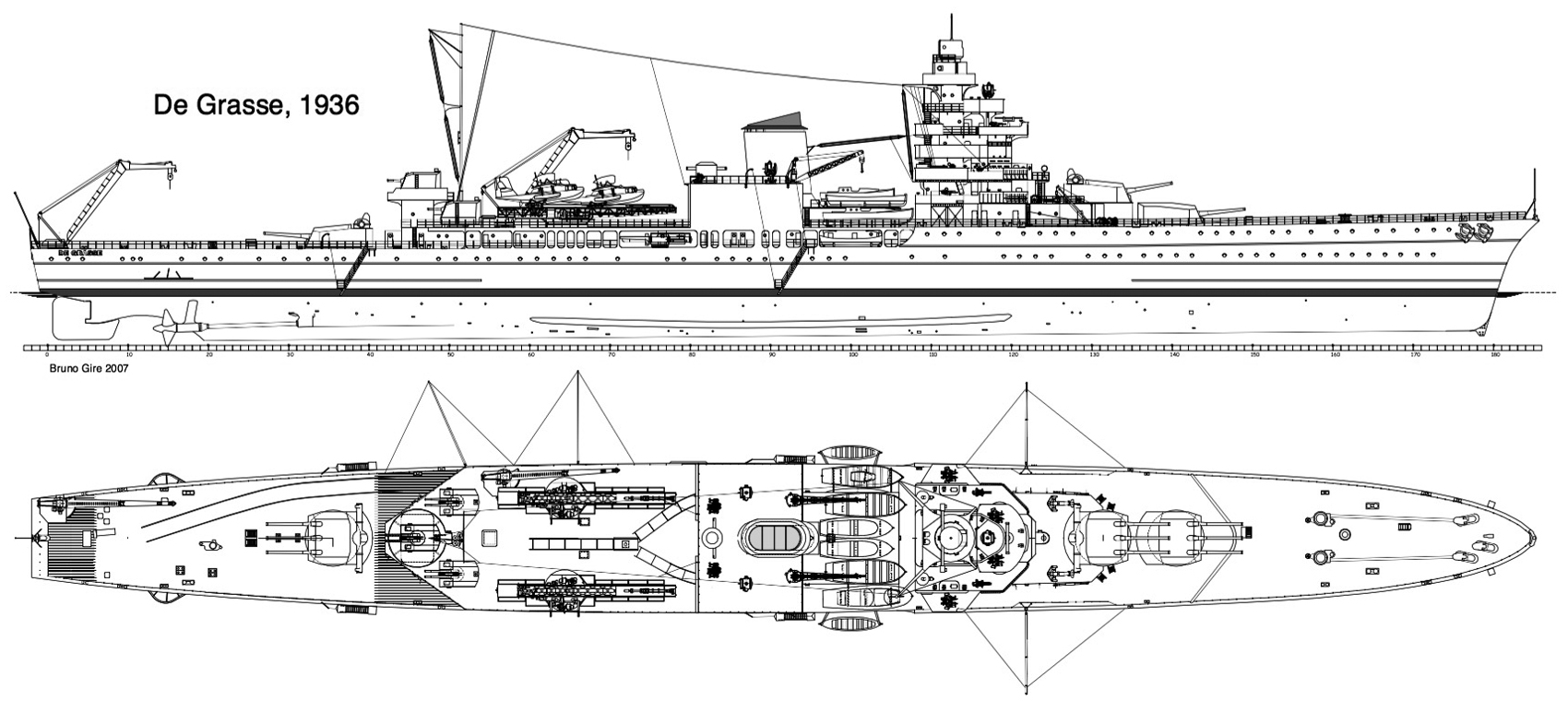
Rendition of the cruiser, from the blueprints, by Bruno Gire in 2007. See the cutaway and comparison with the rebuilt De Grasse
The last prewar French cruiser class was a follow-up of the La Galissonière, with a triple 152 mm guns arrangement (nine times nine inches). It mirrored the St Louis class for heavy cruisers, and the added size meant she was to be more heavily armed on the AA side, and carry three reconnaissance planes. “De Grasse” was named after the famous admiral De Grasse, who played a crucial role in the American war of Independence in 1778. On blueprints, she measured 188 meters (616 ft 10 in) for a beam of 18.6 meters (61 ft) and a draft of 5.5 meters (18 ft 1 in). Displacement was calculated at 8,128 metric tons (8,000 long tons) standard, and up to 11,431 t (11,250 long tons) fully loaded. For extra ASW protection the hull was divided by 15 bulkheads and 16 watertight compartments, combined with underwater longitudinal bulkheads and a double hull for 70% of the hull. She was designed with a transom stern, which was replaced by a standard one during the later rebuilding.

Author’s old rendition of the De Grasse 1938
Design Observations:
-The main armament was nothing revolutionary, the triple turrets went back to the Emile Bertin design (1931), but main guns were -according to naweaps.com- of the old M1920 6.5-in 50 caliber (155 mm) also used by the cruiser Jeanne d’Arc and the Duguay Trouin class. But it was fitted on a completely reworked gun mounts, ensuring independent high elevation. Two turrets, B and C, had their own backup telemeter. There were four more telemeters on the bridge and one on the hangar roof.
-The secondary armament comprised three anti-aircraft turrets with 3.5 inches, 5 caliber turrets (89 mm), all grouped aft on three levels. The design sketch showed one on an elevated platform and two abaft it on the quarterdeck. It was basically an evolution of the trusted 90 mm/50 (3.5″) Model 1926. It used an autofretted barrel and a semi-automatic Schneider breech mechanism, and capable of 12-15 rounds a minute.
-The light AA armament also comprised the old and trusted 25 mm Hotchkiss Mle 1940. They were all in individual high elevation mounts. In Bruno Guire’s excellent depiction, Two are on the bridge and two on the hangar’s roof. The position of the fifth is unknown, possibly above the navigation bridge. Link (naweaps)
-The smaller 13.2 mm (0.5″) Model 1929 are already covered in other articles, we will not spend time here, only mentioning they were provided in two quadruple and two twin mounts, located on the bridge and possibly hangar roof. Link (navweaps)
-The ship was remarkable however in the way she carried no less than four aircraft, like the previous cruisers, all of the medium sized Loire 130 seaplane type, roughly similar to the British Supermarine Walrus. They took place in the large hangar built around the unique funnel, providing enough storage for the planes to be stacked one above the other, and placed on the catapults behind, placed in front of the aft mainmast on the beam. They were served by a single axial gooseneck crane between them. The eight boats carried were stored just behind the bridge, at the feet of the funnel, and served by two small cranes installed on the hangar.
There was another large service gooseneck crane aft, its purpose is unclear but perhaps to handle mines, as rails are shown close by. Besides the unique funnel and hangar built around, the other striking aspect of the De Grasse class was the tall bridge, unlike the most classic tripod of the La Galissonière and previous French Cruisers. It’s not sure how this structure would have played on stability.
1938 design |
|
| Dimensions | 180 x 18.6 x 5.5 m (616ft 10in x 61ft x 18ft 1in) |
| Displacement | 8,128 t standard, 11,431 tons FL |
| Propulsion | 2 shafts Rateau Bretagne geared steam turbines, 4 fuel oil boilers |
| Performances | 63,000 shp (47,000 kW), 34 kts (63 km/h; 39 mph), range 5,000 nmi (9,300 km)/18 kts |
| Armament | 3×3 6-in/50, 3×2 3.5-in/50 AA, 5×25 mm AA, 8×0.59 in (13.2mm) AA, 2×3 21.7 in (550 mm) TTs, 4 aircraft |
| Crew | 580 |
Construction and fate
Construction
Construction of De Grasse started on August 28, 1939 in the Lanester basin, Lorient Shipyard. But in September 1939, construction is suspended, and her sister-ships to be named Châteaurenault (F C de la Méditerranée, La Seyne) and Guichen (F C de la Gironde, Bordeaux), were cancelled before their keels were laid down.
Work was stopped completely until 1940, short of workforce and due to other priorities. Vichy French admiralty had the same problems, already struggling for the maintenance of existing ships in service, so nothing happened before the end of the war and months after.
The cruiser was captured by German troops in June 1940 at about 28% completion. Lorient shipyard previously indeed had to wait for freeing the construction shapes used by the previous last La Galissonière class ships, delays in delivery, low priority compared to other projects (so less workforce assigned) until a complete stop. In 1939 recruitments dried down the workforce but work was still possible, it was stopped by governmental decision.
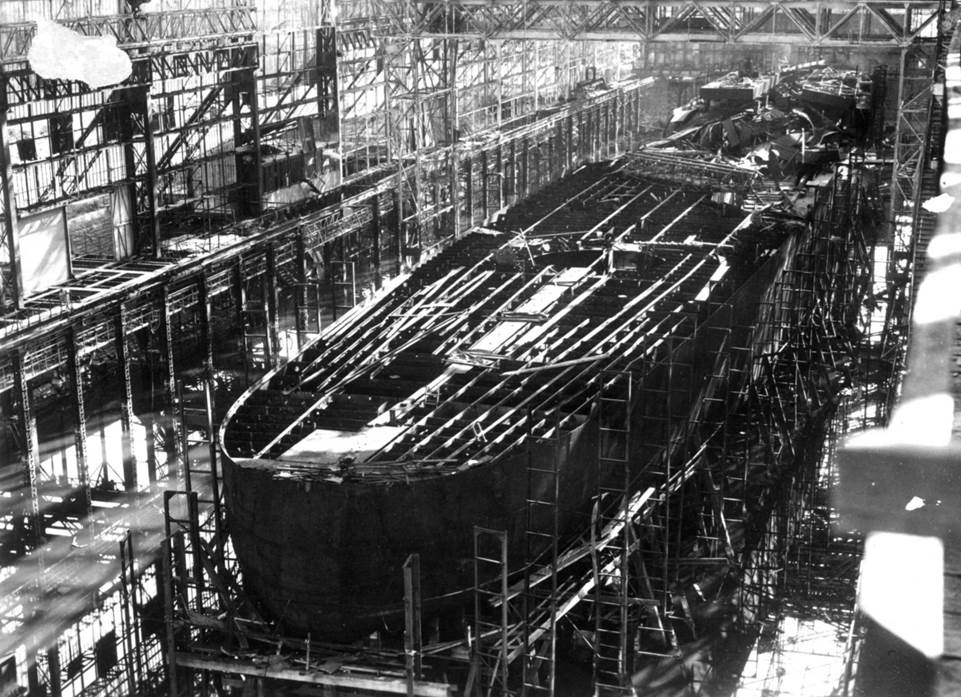
De grasse in construction in 1939. Src naval-group
German conversion projects
The invading Germans sent a Kriegsmarine delegation to inspect captured French ships in construction and discussions went on about her possible use. By April 1942, they started planning to convert her as a light aircraft carrier named “II” (future Standalone post). On 3 December the same year, the free zone fell, more ships were captured in Toulon, and Hitler confirmed the conversion into a light carrier, but work was stopped abruptly in February 1943. Among reasons were materials and manpower shortages, and further disruption because of frequent air attacks in Lorient, where was situated the largest U-Boat base of the Atlantic. Nothing happened but possible damage to the hull until the end of the war. Lorient became a pocket which was recaptured on 10 May 1945. Note: There are no known photo of the De Grasse in construction during the war. If you know one, thanks to contact me.
Due to other priorities for the provisional government, the unfinished hull stayed in place for until a commission reassessed the practicality of completing the hull, at least to replace war losses. However there was no clear consensus over the design, which needed to be radically updated. The hull was eventually completed in 1946, and it was decided at some point to complete her as a modern AA cruiser. Design therefore stopped again to create a brand new design, and the process lasted until 1951. In January, completion work started. At some point however because of human error, the drydock was filled while the ship still had its sea-cocks open. The hull filled rapidly and sank to the bottom of the dock. She was refloated and the modernization progress restarted.
New design as an AA cruiser

Original blueprint cutaway (src netmarine.net).
There was a whole range of modifications attempted as testified by the different between the top profile (as completed in 1956) and the 1936 design below. The armament was a sure choice: The new 127 mm dual purpose automated twin mounts model 1948 would constitute the main artillery, and in total eight were provided and twenty twin 57 mm mounts of the 1951 pattern. There was nothing else, like torpedo banks, despite the fact original plans called for two triple 550 mm banks, they were dropped from the final plans. She became a true AA cruiser, with an extensive electronics and fire control array and some facilities for command and control. The armament was the same as found on the new T47 destroyers, therefore authorized a lead role.
After reconstruction, the hull was lengthened, notably because the transom stern was replaced by a conventional one, and the hull was beamier: It was now measuring 188,03 (overall) for 180,40m between parallels, and 21,50 in beam (18,60 waterline) for a 5,54 (6,30 m FL) draft. She was slightly lighter than the original design despite being larger, displacing 9000 tons standard. The design still had one common point with the 1938 cruiser, the central funnel. Apart that, it was entirely redesigned, with a much larger and sturdier boxy bridge, higher stepped superstructures, no aviation, less boats, placed abaft the funnel, no goose neck cranes, four large main telemeters placed in lozenge (One on the bridge’s roof forward, two either side of the funnel, one aft after the radar. The 57 mm were served by two smaller ones placed either side of the bridge. The mainmast supporting the aerials and navigation/surveillance/tracking radars were placed aft of the main bridge forward. The crew comprised 70 officers, 160 petty officers and 750 quartermasters and sailors.
The compartimentation was as follows: Below the main deck, 16 watertight main bulkheads like for the original design, making for 17 watertight sections. Under the false deck were found the equipment and ammunition bunkers, ballast and water bunkers, air fridge, stores, aft engine, aft boiler room, forward engine, forward boiler room and fuel bunkers, store, auxiliary compartments, various bunkers and chain lockers. Below the main deck were installed the steering gear, various bunkers, crew, diesel and auxiliary positions, admiral and officer quarters, front auxiliaries. Above the main deck, were found the sailors quarters, those for petty officers and officers, local fan auxiliaries, crew stations, workshops and stores. The 1st deck comprised offices, senior officer accommodation, sanitary facilities, kitchens, drunken rooms, hospital, crew stations, the lower bridge comprised the weather rooms, 127 mm artillery, accommodation, cafeteria, laundry room, ventilation, the upper bridge contained the rear ventilation, radar room and annexes, converters, some offices and housing and on platforms, hygiene rooms, ventilation, offices, navigation shelter, and telepointer.
Armament
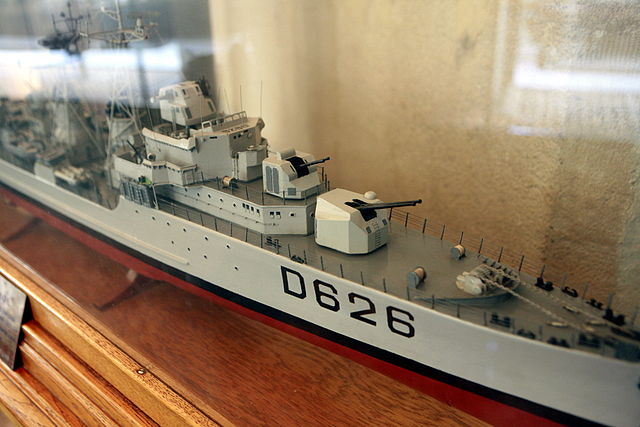
A model of the T47 showing the 127 and 57 mm AA gun turrets.
Main armament:
The 5-in/54 (127 mm) modele 1948 became the standard large caliber AAA of the Marine Nationale in the the 1950s. It was shared by it two modernized cruisers, destroyers like the T47 class, and Jean Bart. It was a completely new design taking full advantage of cheap, largely available US 5-in shell originally designed for surface and anti-aircraft uses. It was the first French first high-angle successful mounting of the French, and a reflection on the threat posed by aircraft attack. It was replaced in the 197s by the excellent single 100 mm Model 1968 gun.
It was a development of the prewar twin 130 mm mounting seen on the Le Hardi DD class, but with reduced caliber for compatibility. Still, automation was not achieved and it required no less 11 personnel per turret, making it heavy and over-complex for its time. It failed to meet its 15 rpm per gun figure and had to go through many modifications before being accepted into service.
The bore length was 270.0 in (6.858 m), and it fired with a 18.5 lbs. (8.188 kg) propellant charge plus 34.1 lbs (15.5 kg) Cartridge a the AAC Mark 41 of 69.45 lbs. (31.505 kg), HC Mark 41, Mark 48 Parachute Flare, the HE Com Mark 42 and VT Mark 41. Muzzle Velocity for the HC type was 2,650 fps (808 mps). With a 80° elevation (-10 depression), the 48 tonnes mount was able to reach 24,060 yards (22,000 m) at 45° in antiship fire, and at 85 degrees, 29,530 feet (9,000 m) for aircraft.
These eight twin 127 mm were placed in lozenge arrangements, with forward and aft guns in tandem, the B and Y position slightly superimposed on their barbettes, and the next two either side of the forward upper deck and aft deck.
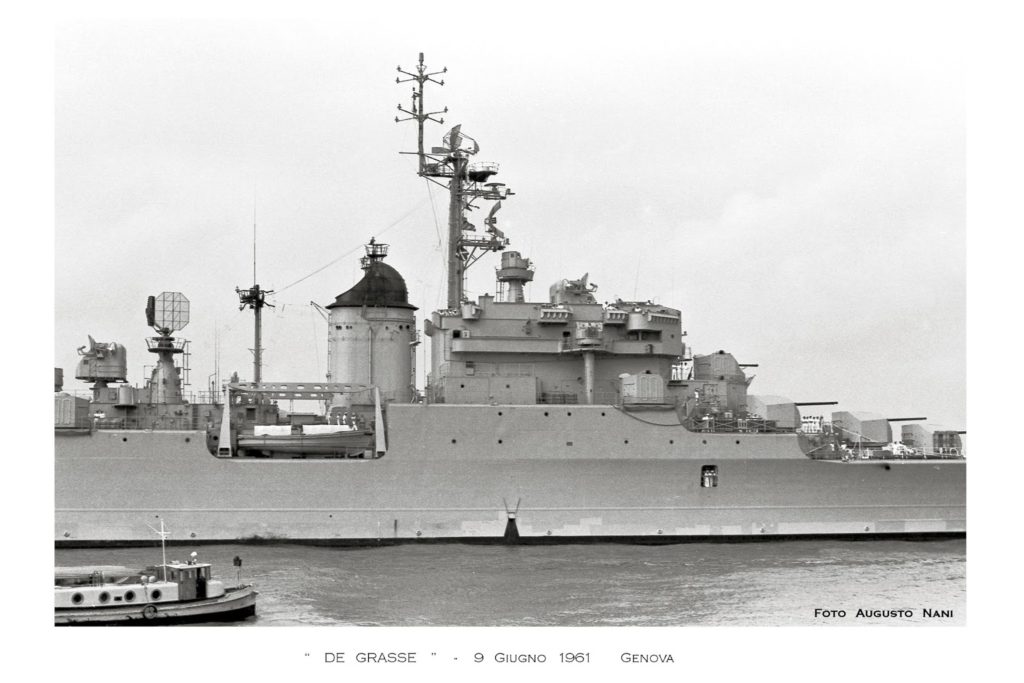
De Grasse in Genoa, 1961. Detail of the bridge and armament by augusto nani, Col. Giorgio Parodi
Secondary armament:
Fr the secondary AA, the French turned to a trusted manufacturer which became the staple of AA defense on all allied ships during the war and made a nice career during the cold war, up to the 1970s. But it was not the 40 mm Bofors, but it’s Swedish successor, the 57 mm/60 (2.25″) SAK Model 1950. The French 57 mm/60 (2.25″) Model 1951 was its development. This water-cooled design also used by the Netherlands was introduced shortly after WW2 as a scaled-up version of the 40 mm/70 Model 1948. The four-round clip was now too heavy for handling, and loaders dropped individual rounds into the ammunition boxes feeding quadrant-shaped hoppers. The same system was also used by Breda.
In a review after the war, the French Conseil Superieur decided the 40 mm Bofors was now inadequate against modern aircraft and preferred the new Bofors 57 mm AA gun in development. Essentially the same as in Swedish service, they were installed in a French-designed twin turret. It fired the HE 5.73 lbs and lighter HE Model 1950 6.53 lbs. (2.96 kg) at 2,840 fps (865 mps), and the turrets had 80 ready rounds plus about 1,500 in magazines.
These 57 mm twin mounts were placed on the secondary upper deck, four aft, two tandem pairs either side of the rear fire directors, and three forward, one either side of the main bridge and one superimposed on an upper deck extending the bridge.
The 5-in were served by two main directors placed on the main bridge and aft position, completed by four secondary directors either side of the bridge and aft.
This armament was considerably downgraded after reconstruction as a command ship later.
In service, the De Grasse served with the French blue water fleet as an escort vessel, but it happened her AA was perhaps a bit too optimistic: The four innermost 57 mm mountings and their respective fire directors were inefficient and deposed in 1961. At the same time she received the new DRBV 20A radar.
Electronics
The electronics suite comprised a DRBV 20A surface surveillance radar, a DRBV 11, DRBI 10, four DRBC 11 and four DRBC 30. All guns were fully stabilized with gun-layers and radar-controlled tracking. Another interesting aspect of the design was its command structure, with coordination of air defence with other ships in the area, and capability to direct air strikes in an assault operation. This task in particular was well managed by the DRBI 10 height-finding radar.
Protection (armour)
Despite a modern design, the cruiser still retained part of its original armour: The armored bridge was 100 mm thick, just as the main belt extending from couple 32 to 144, and over a height of 3.50 m (between barbettes, 1.60 m at both ends. The upper deck armour was 38 mm thick, extending the same length to create the armoured box. This structure protected the ammunition rooms and machinery. But the bridge and turrets were left unarmoured.
Powerplant
There was no significant progress in the design. The original configuration was kept, which ease design work and completion. The ship kept a truncated arrangement of exhaust into one single funnel. The two Rateau-Bretagne steam turbines planned were still efficient in 1950 and provided 110,000 hp. Since armour was absent of kept minimal, top speed was a comfortable 33 knots. However the transom stern was redesigned but despite some savings, the final design was 1400 tons heavier than planned.

Conway’s profile of De Grasse in 1956
1949 design |
|
| Dimensions | 188.62 x 16.6/21.5 x 5.54 m (422.0 x 42 x 18 ft) |
| Displacement | 9,380 t standard, 11,545 tons FL |
| Propulsion | Same as 1938 design |
| Performances | 105 000 shp (120 000 overheat), 33,8 knots |
| Armament | 8×2 127 mm M48 (5 in), 10×2 57 mm M51 (3.5 in) |
| Crew | 950, 980 as flagship, 620 as PCS 1966 |
The De Grasse in service
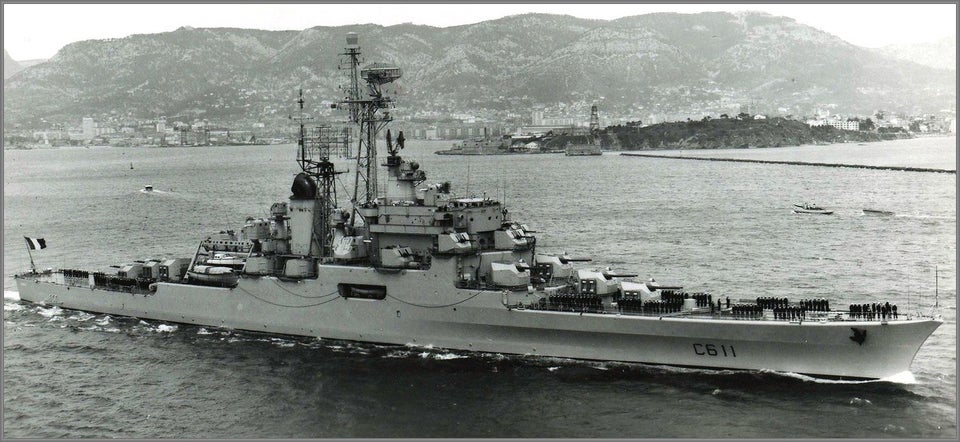
De Grasse underway off Toulon in the 1950s (from reddit)
Fresh from fitting out, De Grasse was prepared for yards tests on August 17, 1954 but only carried out her first sea trials in 1955 off Brest. It started in January 27, and went on in February 9-11, three days in March, on April 13, May 10-14, and 21-27 and in November 15-16. This process went on, with modifications in between until January, February 1956 and June to August. On the 10th at last trials were complete and she left Brest on August 29 for her first mission, in Arzew and Toulon. She was admitted for active service on September 10, 1956.
She was assigned to the 1st F.E.E., carrying out numerous exercises off Toulon (base port) and a yard’s countervisit was conducted on board on December 15th headed by the construction wing Admiral Jozan. She spent 1957-1959 in Exercises with the fleet.
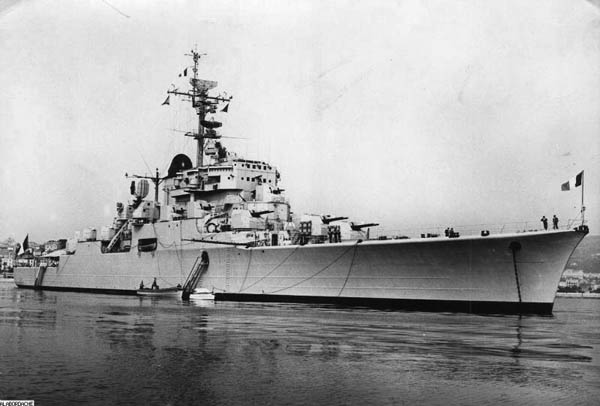
Photo taken by 1st class sailor Georges Rini in 1957, secretary of the amdirals Barjot & Jozan. Src: Forum alabordache.fr (archive)
In 1957 she left Toulon for a mission to Ajaccio on February 23th and Cannes on March, 9th, then Mers el-Kébir, Algiers, Arzew, and back to Toulon on April, 6th. She made an artillery training on April 25 and particpated in exercises Atout and NATO’s Medflex Epic, stopping at Naples on April 30. Back to Toulon she left egain for her first long cruise on May 11. This brough her across the Atlantic to the West Indies. She arrived in Fort-de-France, stopped at les Saintes, then headed for Norfolk, New-York, and crossed back to the Mediterranean, arrived at Casablanca and returned to Toulon on July 12. She was sent in drydoc for a maintenance overhaul and fittings, notably work on her boilers in 15-4. She left in September 1957 for exercises and departed for a cruise, stopping at Bône, Philippeville, Algiers and back in Toulon, on September 28, and a new refit from October 1957.
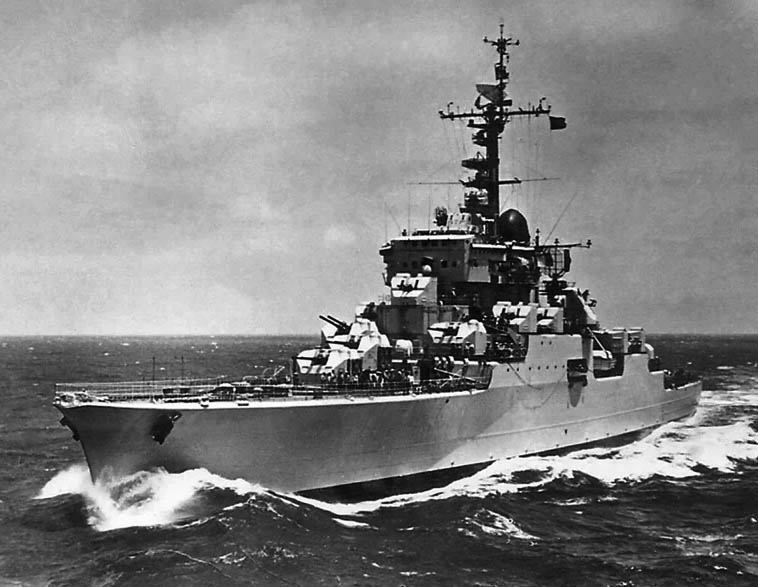
De Grasse underway at sea – src unknown, from Reddit
She returned to duty in January 4, 1958, leaving Toulon the 9th for Bizerte and headed for Ajaccio and back on the 19. Exercises followed until mid-February and she was in maintenance period January 24-30. On the 20 February she sailed to Algiers and was back to Toulon in March, departed again for Arzew and Mers el-Kébir and back on March 22. Maintenance followed in May including the replacement of a damaged boiler. On May 18 she was back at sea for her spring cruise. She stopped in Messina, Palermo, Naples, Algiers, Bône, La Sude (Crete), Beirut, and Jounié. Sehe was back in Toulon on August 2 and unavailable until September 17. Next, followed various exercises off Toulon until November and December 19, with stops in Algiers, Mers el-Kébir, and Villefranche in between. At the start of 1959, she sailed to Les Salins and Villefranche during exercises in January(February, and was refitted at Toulon in March-April. She sailed in mission to Malta and Bizerte and was back in April 16 for NATO exercise Medflex Guard.
Unavailable from April 20 to 29, she started her spring cruise from April 28, up to June 25, stopping in Naples, Santorini, Piraeus, Phalera, Istanbul, Bone, Mers el-Kebir and Algiers. In maintenance from June 26 to August 4, she was back for exercises off Toulon and Cannes until November. On November 24 she sailed for Oran, Mers el-Kébir, Algiers, Agadir, Dakar, Gibraltar and left the Mediterranean for Brest Naval Base on December 22. Indeed she was to be refitted there, a serie of modifications. The first, limited phase, started on December 23, 1959, and went on until January 18, 1961.
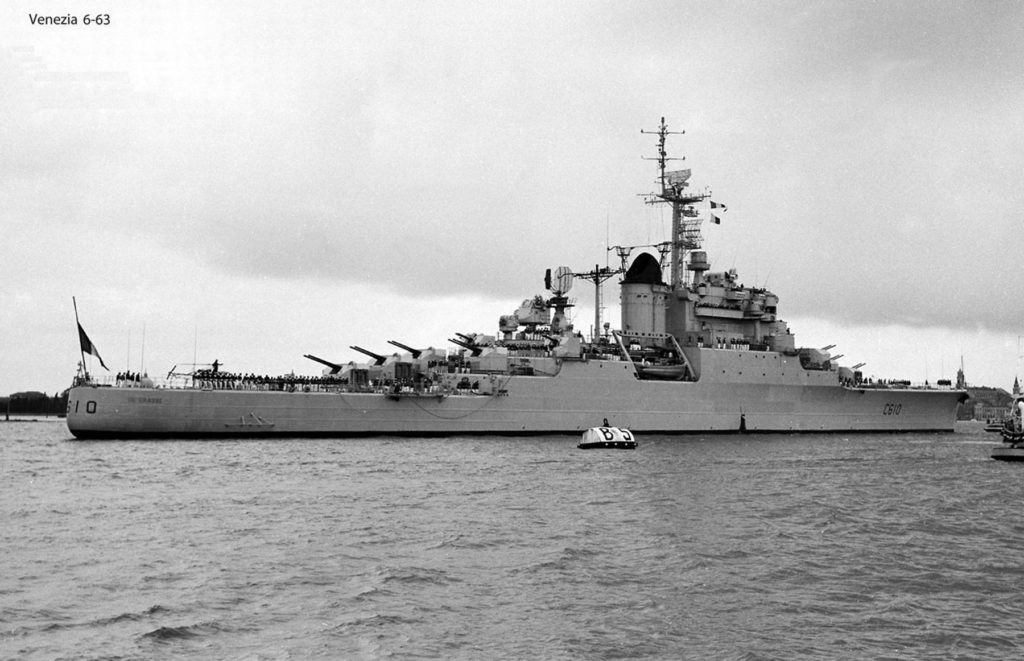
De Grasse in Venice -src unknown, reddit

The very similar Colbert in 1959, photo by U.S. Navy All Hands magazine December 1959, international fleet review.
At the start of 1961, De Grasse left Brest for a series of tests (18-20 January, February, and early March), stopping in Plymouth on March 23, back to Brest and departing again on April 28 for Toulon. On May 6, she stopped at Mers el-Kébir and was reassigned to the Mediterranean squadron, in exercises interrupted by maintenance at the end of the month. She left Toulon on June 2 Genoa and on June 29 for Bizerte, with stops at Toulon in between, and a small refit from September 25th to October 14th. She then took part in Medaswez 46 exercise in November, stopping in Malta and Mers el-Kébir. By December 15, she left for Oran, and stopped at Mers el-Kébir and Algiers back on December 23 and in maintenance until January 14, 1962.
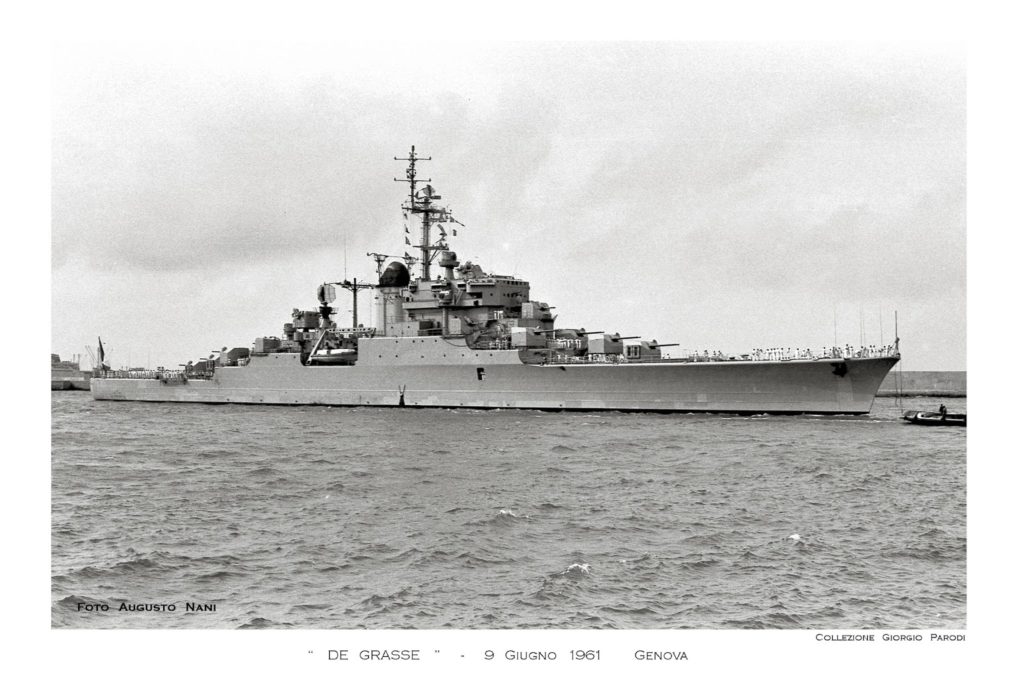
De grasse in Genoa, 1961. Collection Giorgio Parodi
1962: The great world cruise
1962 saw De Grasse making a world cruise, lasting for more than 8 months, stopping in 45 ports along the way. After a few exercises in the Mediterranean until the end of January, she left Toulon on February, 3, for Dakar (Senegal, Western Africa). From there she crossed the Atlantic to the West Indies: Fort-de-France, Les Saintes, Pointe-à-Pitre, Saint Barthélémy, Saint Martin, Cristobal, Balboa, Clipperton. She crossed the Panama Canal and arrived in San Diego, then departed for Honolulu (Hawaii) and went on in the pacific south, arriving in French Polynesia (Nuku Hiva, Hiva Oa, Papeete, Rangiroa, Fakarava). She then departed to The Gambier Islands and headed for New Caledonia, in Raevavae, Nouméa, Taridou, Lifou, Uvéa, Efate, Port Vila (Efate), Norsup (Malekula), Fauna (Espiritu Santo), Tanna, Poindimié, and Port Darwin (northern Australia). She headed for the Southwest Asia, arriving in Saigon, then heading west to Colombo, Diego Suarez in the Indian Ocean, the Reunion Island, and Madagascar (Tamatave, Tulear, Juan de Nova, Majunga), then Dzaoudzi (Mayotte), Moroni, Djibouti, and Suez. She crossed the canal to Alexandria and headed back to Toulon on October 9, 1962. She was in a well deserved maintenance in October-November and December. She also took part in the last exercises in this year, stopping at La Spezia.
In 1963 she was back at the head of the Mediterranean Squadron, resuming her exercises routine. By January 1963 she operated off Toulon and in February and March went on in another cruise in the Atlantic, stopping at Las Palmas, Dakar, Abidjan, Port Etienne and back to Casablanca in North Africa. She underwent a small refit in March-April stopped in Marseille and Cannes and headed east for more exercises off Greece and in the Aegean islands: Salonika, Mykoni Delos, Santorini, Rhodes, Taranto, Corfu, the adriatic (Venice, Catania) and back to Toulon on June 21. In August she was off Corsica, stopped in Ajaccio and was back to Toulon on September 25. She departed again for the Indian Ocean, crossing the suze canal. She stopped in Djibouti, and Mahé (Seychelles), then Madagascar (Diego-Suarez, Port Louis, Massawa) and back to Toulon on December 20. She was in maintenance until January 7, 1964. By then the admiralty had new project for her. This was her last year as an AA cruiser and flagship:
Leaving Toulon the next day, she stopped at La Maddalena during an exercize and was back in February 8 in Toulon, in maintenance for a week. She then left Toulon for the last time, stopping in Gibraltar in May 4-6 before reaching Brest on May, 10th. She entered the drydoc for her major (last) reconstruction and tranformation of her career.
This major refit started officially on May 10, 1964 and went on for two years, until February 1, 1966.
1966 reconstruction as Pacific Command Ship
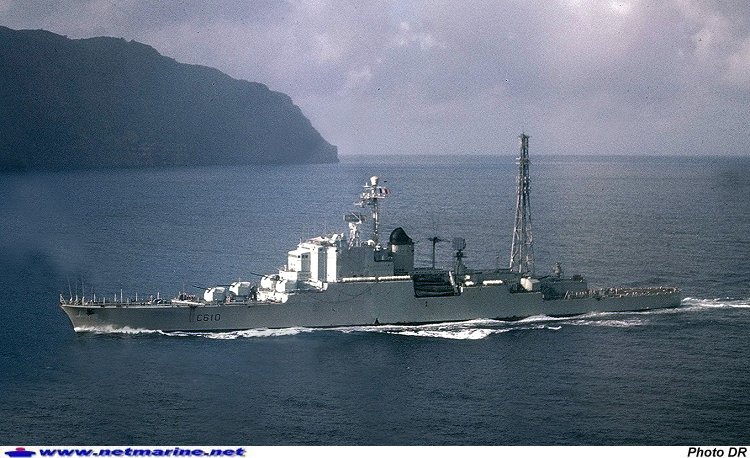
De Grasse as a command ship after reconstruction. Src netmarine.net
In 1966, De Grasse AA role was now taken over by missile vessels, but she was still a roomy ship, valuable for other roles. So it was decided to convert her for the Pacific experimental centre in Tahiti, both as flagship and command ship. Little attention was given to her ageing powerplant but usual maintenance as she was destined to be almost permanently anchored. However her facilities were completely overhauled and she was partially disarmed:
-Extended signals operating C&C room
-50 m tall lattice mast raised aft with communication long range array antennae
-Aft 5-in mounts removed
-All 57 mm mounts removed
-All directors but the main forward one removed.
-Former search radars replaced by a single DRBV 23.
-Additional protection against radiation fallout (isolation, NBC type, overpressure system)
-Gateway block is doubled
-All accommodation and electrical systems are modernized
-New electric generators
-Displacement fell to 9,000
-Complement now down to 500
-Accommodate for 120 engineers and technicians (Mururoa test team).
The goal was to use her as a command ship for the nuclear tests of the Pacific, in Mururoa, French Polynesia as part of De Gaulle’s deterrence policy. Her communication set allowed her both to command the explosion at a safe distance and to communicate directly with Paris, for the tests greenlight.
She became the de facto the “atomic command ship” of the French Navy. She kept this role until 1973 until the pacific tests “open air” campaign stopped, amidst violet international protests and the presence of RNZN warships. France abandoned atmospheric nuclear testing in 1974 for undergound ones. In particular, the 41st test which took place over Mururoa Atoll on 17 July saw the atomic cloud taking a competely different trajectory than planned and ended over most of the inhabitants of Tahiti and the surrounding islands of the Windward group leading to widespread contamination. To this day, there is an expert battle over the amplitude of contaminations, some argues over 110,000. The French Government have yet to declassify these 1970s documents (top secret for at least 50 years). So far the CEA (atomic energy commission) study only led to 63 Polynesian civilians compensated. In total, France performed 193 tests in the South Pacific between 1966 and 1996.
De Grasse left Brest for the Pacific on March 8, 1966. Anchored close to Mururoa atoll or Fangataufa, she operated as semi-permanent command ship until the end of 1972, carriying out seven atomic fire campaigns for the benefit of the DIRCEN (Directorate of the Center for Nuclear Experiments), later CEA. She headed back home nevertheless every winter for her IPER (Periodic Unavailability for Maintenance and Repairs). One of these ealy campaigns saw the first shot from a balloon (Betelgeuse test) in presence of General De Gaulle, observing the test from the bridge. The Betelgeuse test was trigerred manually by De Gaulle himself from De Grasse’s bridge at 7:30 am on September 11, 1966. The atomic yeld was just under 200 kt.
Captain Jaouen took command of De Grasse while in maintenance in Brest (her home port until the end of her career) on November 29, 1971. She made her final trip to Mururoa as part of a new nuclear test campaign. In September 1972 she was placed in special reserve B but was only back in Brest by December 9, 1972. The reserve was only effective from March 20, 1973. She headed for the disarmament dock and apparently while en route, the captain knowing her excellent propulsion pushed De Grasse machinery to 33 knots that day, arriving one day earlier than planned in Brest.
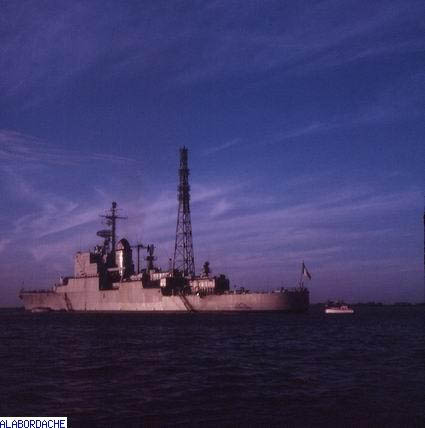
De grasse, stern view, 1971 (src alabordache.fr)
In 1973-1974, De Grasse was kept in reserved, watched over by a small guard crew, waiting for her fate. She was condemned on January 25, 1974 (decree number 7), renamed with the disarmament number (hull) Q521, handed over to Brest with a planned sale to be broken up. Having no longer any military value, the age of her hull negated any possible conversion. A possible use as museum ship was also brushed apart due to her contamination, even light, being a hazard for the public. In addition, she would have been reverted to her 1950s appearance, a too costly prospect to consider. Her near-sister-ship Colbert had this chance however.
Documentary: De Grasse 1962 world tour (Fr)
More resources
Sites:
http://www.netmarine.net/bat/croiseur/degrasse/index.htm
https://fr.wikipedia.org/wiki/De_Grasse_(croiseur)
http://www.navypedia.org/ships/france/fr_cr_de_grasse.htm
http://www.navweaps.com/Weapons/WNFR_5-54_m1948.php
http://www.navweaps.com/Weapons/WNFR_57-60_m1951.php
On forummarine.forumactif.com
The De Grasse on naval analyses
archive – alabordache forum (FR)
Extra photos – same source
Heller Model forum discussion
Books:
Conway’s all the world’s fighting ships 1947-1995
Kriegstagebuch der Seekriegsleitung 1939–1945 in 68 Bänden (Herford 1988–1996)
Erich Gröner, Dieter Jung, Martin Maass: Die deutschen Kriegsschiffe 1815–1945, Bernard & Graefe
Frank Omeda: Die deutschen Flugzeugträger. Von den Anfängen bis 1945 (E-Book 2012)
John Jordan and Bruno Guire, The Cruiser de Grasse in Warship 2008 (Conway’s)
J. Jordan, J. Moulin (2013). French Cruisers 1922–1956. Seaforth Publishing
MOULIN Jean, BAIL René, Les croiseurs De Grasse et Colbert, Marines Ed.
The model kit corner
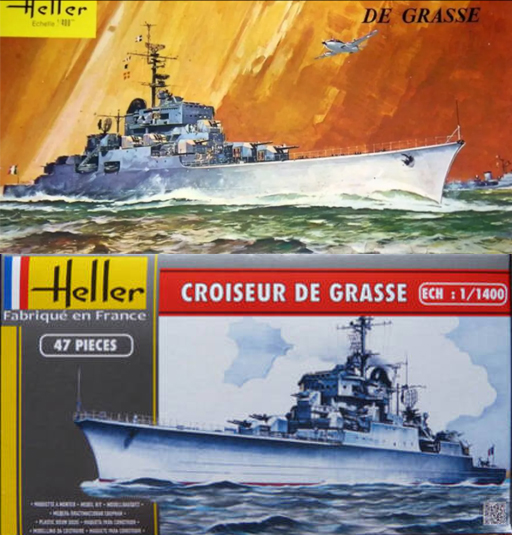
The De Grasse was a best-seller for Heller at 1/400 a,d 1/1400 scale (below) for many years. It was first released in 1963 and re-edited seven time until 2000.
It was also sold by Progresswerk Nürnberg in Germany, in a new box as the “colbert”
Not a popular model outside France.


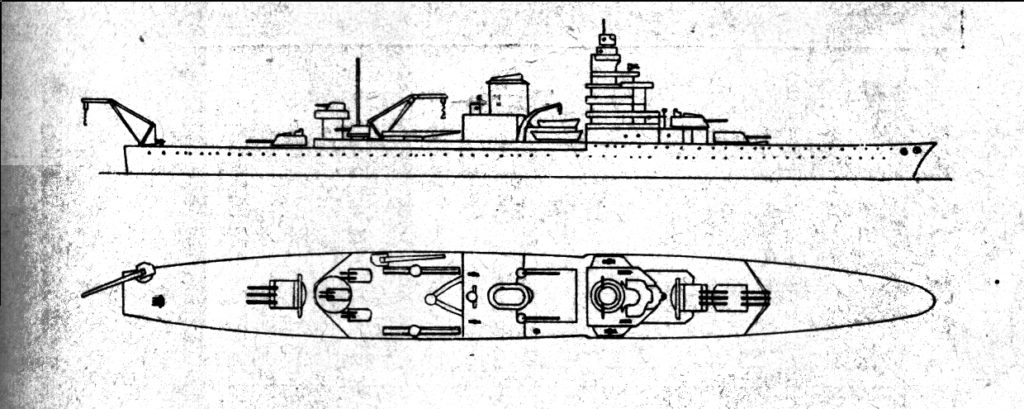
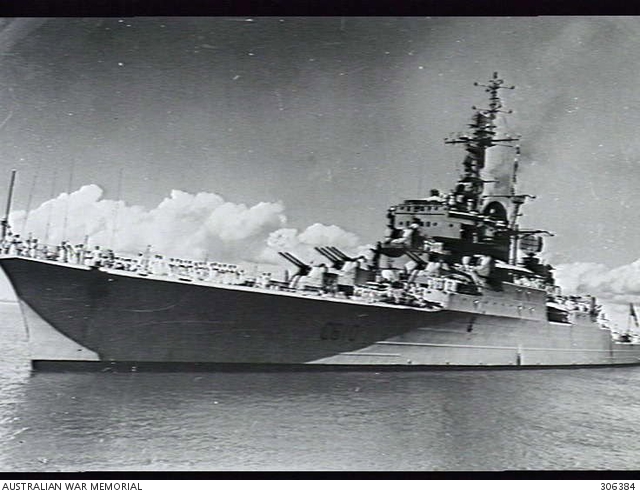
 Latest Facebook Entry -
Latest Facebook Entry -  X(Tweeter) Naval Encyclopedia's deck archive
X(Tweeter) Naval Encyclopedia's deck archive Instagram (@navalencyc)
Instagram (@navalencyc)





 French Navy
French Navy Royal Navy
Royal Navy Russian Navy
Russian Navy Armada Espanola
Armada Espanola Austrian Navy
Austrian Navy K.u.K. Kriegsmarine
K.u.K. Kriegsmarine Dansk Marine
Dansk Marine Nautiko Hellenon
Nautiko Hellenon Koninklije Marine 1870
Koninklije Marine 1870 Marinha do Brasil
Marinha do Brasil Osmanlı Donanması
Osmanlı Donanması Marina Do Peru
Marina Do Peru Marinha do Portugal
Marinha do Portugal Regia Marina 1870
Regia Marina 1870 Nihhon Kaigun 1870
Nihhon Kaigun 1870 Preußische Marine 1870
Preußische Marine 1870 Russkiy Flot 1870
Russkiy Flot 1870 Svenska marinen
Svenska marinen Søværnet
Søværnet Union Navy
Union Navy Confederate Navy
Confederate Navy Armada de Argentina
Armada de Argentina Imperial Chinese Navy
Imperial Chinese Navy Marinha do Portugal
Marinha do Portugal Mexico
Mexico Kaiserliche Marine
Kaiserliche Marine 1898 US Navy
1898 US Navy Sovietskiy Flot
Sovietskiy Flot Royal Canadian Navy
Royal Canadian Navy Royal Australian Navy
Royal Australian Navy RNZN Fleet
RNZN Fleet Chinese Navy 1937
Chinese Navy 1937 Kriegsmarine
Kriegsmarine Chilean Navy
Chilean Navy Danish Navy
Danish Navy Finnish Navy
Finnish Navy Hellenic Navy
Hellenic Navy Polish Navy
Polish Navy Romanian Navy
Romanian Navy Turkish Navy
Turkish Navy Royal Yugoslav Navy
Royal Yugoslav Navy Royal Thai Navy
Royal Thai Navy Minor Navies
Minor Navies Albania
Albania Austria
Austria Belgium
Belgium Columbia
Columbia Costa Rica
Costa Rica Cuba
Cuba Czechoslovakia
Czechoslovakia Dominican Republic
Dominican Republic Haiti
Haiti Hungary
Hungary Honduras
Honduras Estonia
Estonia Iceland
Iceland Eire
Eire Equador
Equador Iran
Iran Iraq
Iraq Latvia
Latvia Liberia
Liberia Lithuania
Lithuania Mandchukuo
Mandchukuo Morocco
Morocco Nicaragua
Nicaragua Persia
Persia San Salvador
San Salvador Sarawak
Sarawak Uruguay
Uruguay Venezuela
Venezuela Zanzibar
Zanzibar Warsaw Pact Navies
Warsaw Pact Navies Bulgaria
Bulgaria Hungary
Hungary

 Bundesmarine
Bundesmarine Dutch Navy
Dutch Navy Hellenic Navy
Hellenic Navy Marina Militare
Marina Militare Yugoslav Navy
Yugoslav Navy Chinese Navy
Chinese Navy Indian Navy
Indian Navy Indonesian Navy
Indonesian Navy JMSDF
JMSDF North Korean Navy
North Korean Navy Pakistani Navy
Pakistani Navy Philippines Navy
Philippines Navy ROKN
ROKN Rep. of Singapore Navy
Rep. of Singapore Navy Taiwanese Navy
Taiwanese Navy IDF Navy
IDF Navy Saudi Navy
Saudi Navy Royal New Zealand Navy
Royal New Zealand Navy Egyptian Navy
Egyptian Navy South African Navy
South African Navy






























 Ukrainian Navy
Ukrainian Navy dbodesign
dbodesign